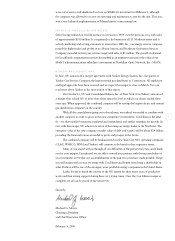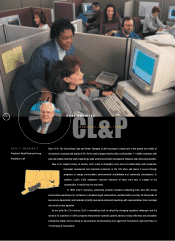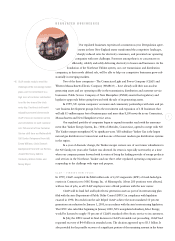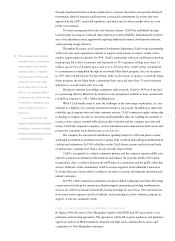Eversource 1999 Annual Report Download - page 17
Download and view the complete annual report
Please find page 17 of the 1999 Eversource annual report below. You can navigate through the pages in the report by either clicking on the pages listed below, or by using the keyword search tool below to find specific information within the annual report.
Seabrook Station in New Hampshire also achieved excellent results in 1999. The plant’s
capacity factor for the year was 86.4 percent, despite conducting a scheduled refueling
outage. From the start of its seventh operating cycle until the end of the year, the plant achieved
a cycle capacity factor of over 98 percent. In 1999, Seabrook’s safety and operational per-
formance improved in a number of key areas, while the cost of production decreased. During
the past year, over $19 million was invested in new plant modifications to improve person-
nel safety, reduce the length of future refueling outages and increase the efficiency of plant
operations and maintenance. For 2000, the station will continue to implement its strategic
initiatives to further enhance safety, operational performance and reduce production costs.
A SUCCESSFUL TRANSITION TO THE MILLENNIUM
NU capped five years of planning and adapting its information technology systems, software
and devices with date sensitive computer chips with an incident-free, successful transition to the
year 2000. More than 650 NU system employees directly supported the effort. YES also made a
smooth transition into 2000. As a result of exceptionally detailed planning, efficient work processes
and superb project management, NU achieved Y2K readiness on time and 50 percent under the
original budget estimate.
As deregulation takes effect throughout our service area, our unregulated
competitive businesses are seizing opportunities for growth.
In 1999, Select Energy, Inc. increased its revenues to approximately
$550 million from $30 million in 1998, while over that same period its
customer base increased to 17,000 from 6,000. During the past year, Select
Energy expanded its portfolio to include the wholesale marketing activities
formerly carried out by NU’s regulated businesses, and has become New England’s
leading competitive energy provider.
In 1999, Select Energy was awarded a power supply contract worth $100 million by
Boston-based NSTAR, the former BEC Energy (Boston Edison) and Commonwealth Energy System.
This six-month contract, which runs through June 30, 2000, follows Select Energy’s prior 12-month
contract to supply power to Boston Edison customers who chose standard offer electric service.
Select Energy also provides wholesale power supply for CL&P and GPU Energy’s Metropolitan
Edison Company and Pennsylvania Electric Company. The CL&P contract will generate anticipated
revenues of approximately $1.5 billion over its four-year term, while the one-year GPU deal will
produce $50 million in revenue.
On the retail side, Select Energy has moved aggressively to market its energy supply and
services portfolio. In Connecticut, Select Energy became the first licensed supplier of competitive
electric generation services. In 1999, Select Energy contracted with 79 municipalities in Massachusetts
to provide power and energy efficiency services. Select Energy is also registered to sell natural gas
through all of the major local distribution companies in the state. In Rhode Island, the company
sells energy and monitoring services to large commercial customers and, through the Rhode
Island League of Cities and Towns, to local municipalities. The company is also active in New
York, New Hampshire, Pennsylvania, Maine, New Jersey, Maryland and Delaware.
COMPETITIVE BUSINESSES
15
























